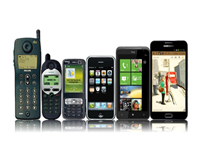This Day in History: April 3, 1973
Additional Date: April 3, 1973
The basic concept of cellular phones began in 1947, when researchers began to examine crude mobile (car) phones. These researchers realized that by using small cells (range of service area) with frequency reuse they could increase the traffic capacity of mobile phones substantially. However, at that time, the technology to do so was nonexistent.
On April 3, 1973, Motorola employee Dr. Martin Cooper placed a call to a rival, Dr. Joel S. Engel, head of research at AT&T's Bell Laboratories. In 1978, Bell Labs launched a trial of the first commercial cellular network in Chicago. This network was not approved by the FCC until 1982. The first commercial launch of cellular telecoms was done by NET in Tokyo, Japan in 1979, and in 1981, the NMT system was launched in Denmark, Finland, Norway and Sweden.
Cellular phones became commercially popular in South Africa in the 1990's, and today it is estimated that 60% of South African households own a cellular telephone. This is significant in terms of development, as cellular phone technology provides internet access to South Africans in rural areas. Research shows that cellular phone usage has increased dramatically in South Africa. It also shows that people are using cellular phones to access the internet and instant messages and social networks. About 61% of internet users in rural areas are accessing it through mobile phones.
